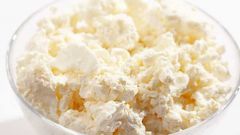The composition of the cheese, its good
The starting material for the preparation of cheese - milk. Cheese contains from 0.5 to 20.0% fat, 13.0 to 16.0% of protein, 1.0 to 1.5% of carbohydrates. The caloric value of 100 g product ranges from 60.5 to 250.0 kcal. Cheese is a source of potassium, calcium, phosphorus, sodium, magnesium, iron, zinc, copper, fluoride, vitamins b, PP, P, E, provitamin A, folic acid. Quite a lot contained in the cheese of choline is present in lecithin.
The use of cottage cheese in the food helps to restore and maintain health. Because of the favorable combination of minerals, the presence of large quantities of microelements and proteins, and essential amino acids — methionine this product is included in the medical and baby food. The availability of nutrients in the composition of the product can be used in diets in the treatment and prevention of atherosclerosis, obesity liver, to maintain the functions of the digestive system, liver and biliary tract, pancreas, cardiovascular system, respiratory, blood, nervous system. Cottage cheese diet will be beneficial for patients with diabetes, weakened patients, and also for people who have suffered burns or trauma.
The methionine content of cheese is second only to flour made from soy.
How to digest cheese
The curd is digested in the stomach within two to three hours. To determine the time of digestion must be considered, when the product has been eaten. In the afternoon the digestion of the person stronger, and cottage cheese are digested in 2 hours. If the product is eaten in the morning or in the evening, this time increases to three hours and several more. In the intestine, proteins and fats this product absorbed relatively quickly, even faster than egg albumin. It is best to digest fresh cheese of the highest grade of milk, not subjected to prolonged heat treatment.
Milk proteins after the action of the high temperature assimilated in the body completely.
Don't eat cheese, especially fat, as much as you want, because it "loads" the kidneys, the digestive system can cause constipation. In small amounts it should have in infectious diseases of the intestine, the therapy which is associated with the use of "Biomitsin, Etazol, Sulgin". This product is a favorable breeding ground for the propagation of pathogenic microorganisms. For example, the causative agent of poliomyelitis in the cheese retains viability for 4 months. The product is perishable, storing must be executed sanitary-hygienic requirements.


